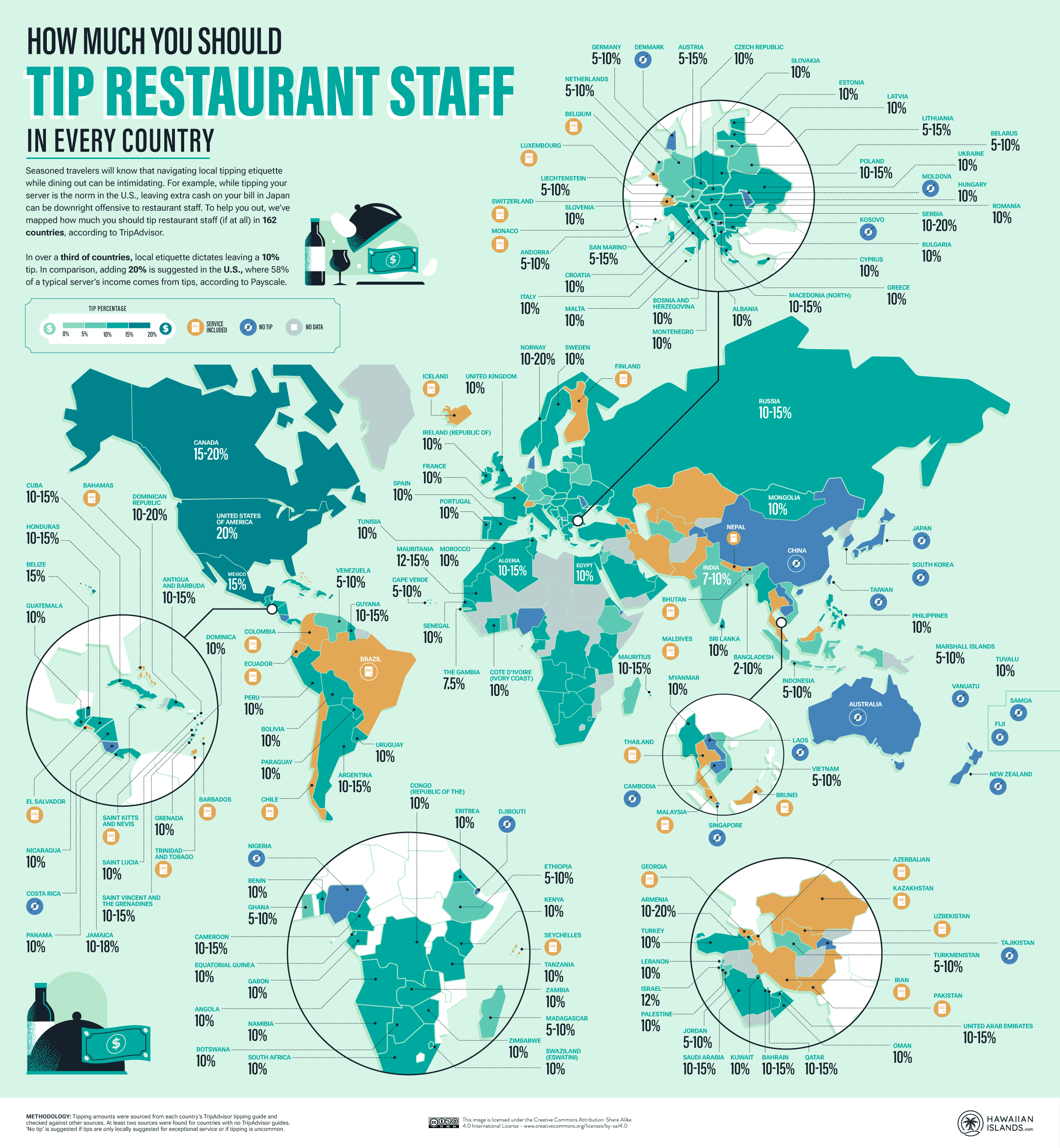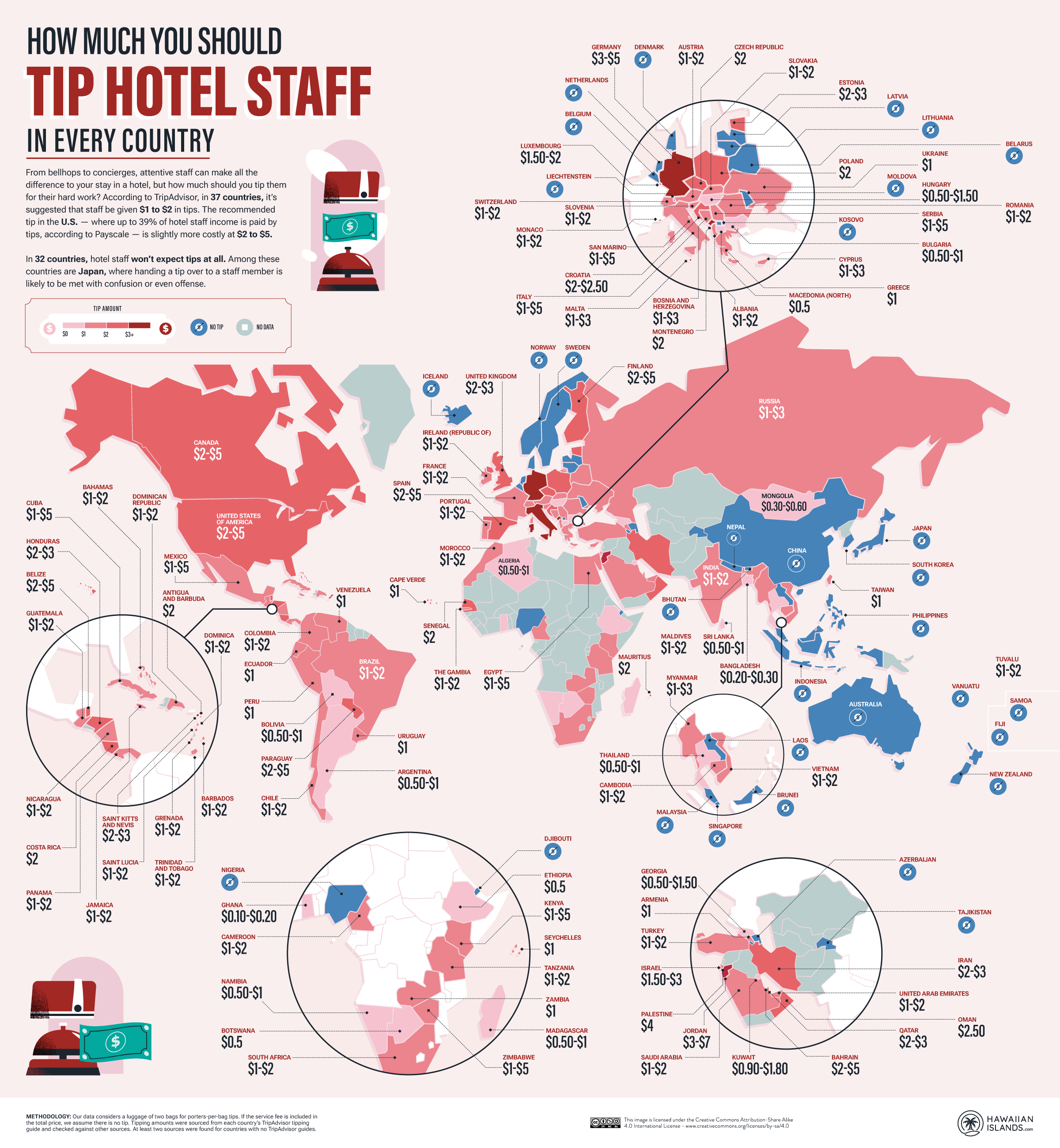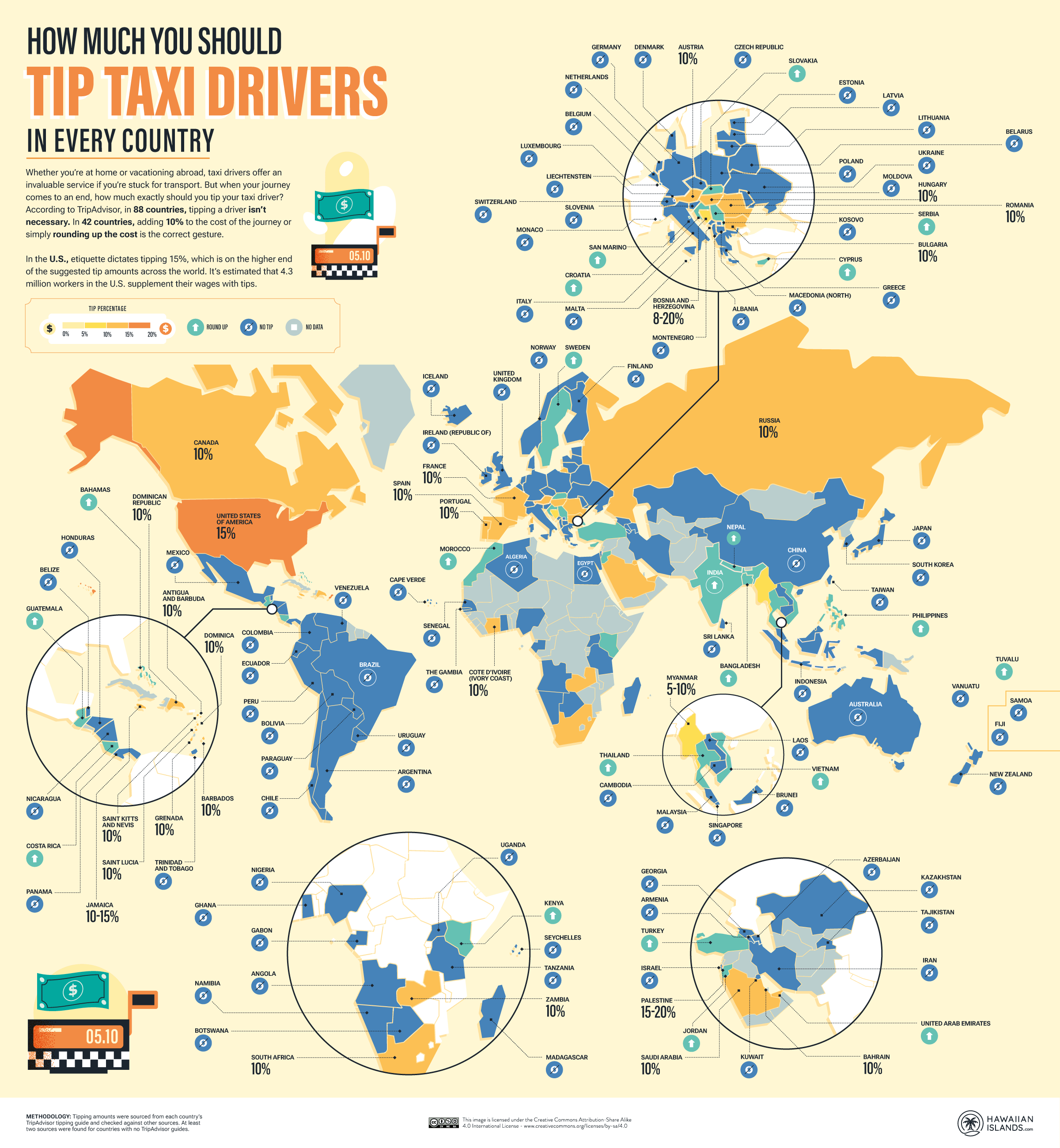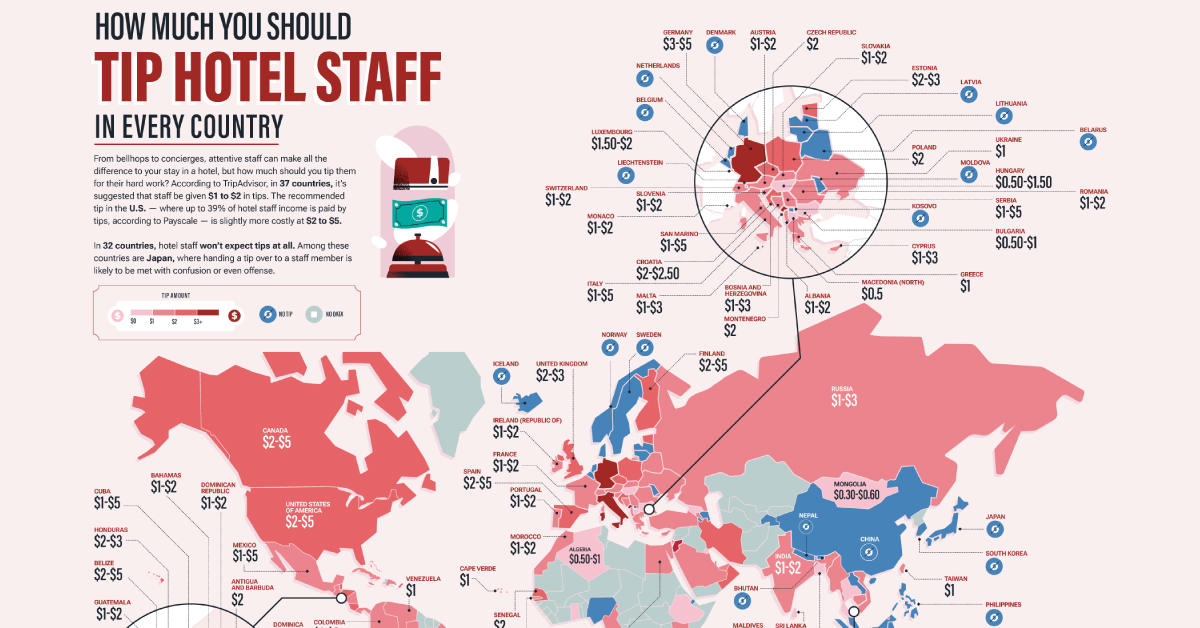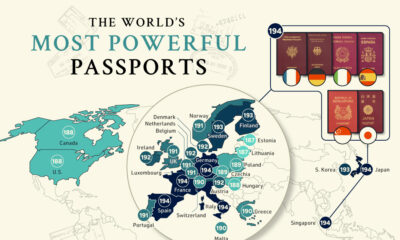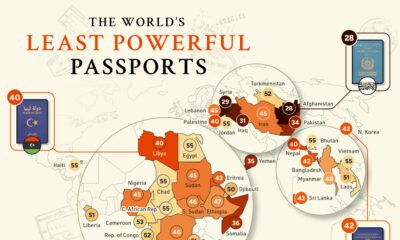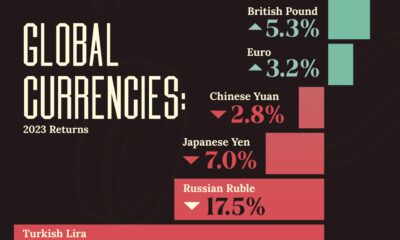Culture
Mapped: How Much Should You Tip In Each Country?
Click to view this graphic in a higher-resolution.
How Much Should You Tip In Each Country?
How much should you tip when traveling abroad? The answer can vary wildly depending on the country and what type of service you are using.
In some countries like the U.S., tipping has become an integral part of work and service culture. Whether you are grabbing a coffee, ordering food delivery, or visiting a hotel on vacation, tipping becomes a part of your expenses.
But in others, tipping is not encouraged and can even be frowned upon. So how do you know which tipping culture you’re interacting with?
These maps from Hawaiian Islands studied the tipping trends across 162 countries, looking first at TripAdvisor’s tipping etiquette guides for each country then cross-referencing with other articles on tipping in those locales.
How Much Should You Tip at Restaurants?
Exploring local cuisine and trying out different restaurants can be an important part of an international holiday, but so is understanding each nation’s tipping etiquette.
For example, while servers and bartenders in the United States—the only country with a 20% recommended tip—often depend on tips to supplement wages, tipping at a restaurant could be considered an insult in Japan, China, or South Korea, where employers include higher service standards as part of wages.
Also consider that the maximum expected tip can vary. If you are at a restaurant in Canada, Serbia, or the Dominican Republic, tips of around 20% would be at the top of the typical expected range. Meanwhile, 66 countries welcome a 10% tip.
Some countries also have “mandatory tips” in the form of service charges or gratuity for larger parties. Others like India have banned restaurants from mandatory tipping.
Tipping For Lodging
Click to view this graphic in a higher-resolution.
Whether you’re staying abroad, tipping may be expected for you to get the best service from the concierge desk, bellhop, or cleaning staff .
If you are in the U.S. or Canada, lodging staff tips range from $2‒$5 USD. On the other extreme, in countries like Argentina, Thailand, and Sri Lanka, you can get away with a tip of 50 cents.
For many other countries in the world, including Brazil, Mexico, and India, tipping etiquette and expectations usually amount to $1 to $2 in hotel staff tips.
Tipping For Transport
Click to view this graphic in a higher-resolution.
When you’re not traveling with your own rented car or public infrastructure, travelers look to local taxis and ridesharing services like Uber and Lyft for convenient ways to explore new places.
Interestingly, these drivers do not expect any tips in 88 countries around the world. Many countries including India, Sweden, and Morocco simply round up the cab fare as a small tip.
In 21 other countries including Canada, cabbies are usually tipped 10% over the price of the ride. But the U.S. tops the list with a tipping etiquette of 15% for taxi rides.
How Much Should You Tip For Different Services?
How does each country’s tipping culture vary by service, and how do they compare? And which countries don’t have tipping data available?
This interactive table helps you explore the map data directly by searching for your country of choice:

This article was published as a part of Visual Capitalist's Creator Program, which features data-driven visuals from some of our favorite Creators around the world.
Technology
How Tech Logos Have Evolved Over Time
From complete overhauls to more subtle tweaks, these tech logos have had quite a journey. Featuring: Google, Apple, and more.

How Tech Logos Have Evolved Over Time
This was originally posted on our Voronoi app. Download the app for free on iOS or Android and discover incredible data-driven charts from a variety of trusted sources.
One would be hard-pressed to find a company that has never changed its logo. Granted, some brands—like Rolex, IBM, and Coca-Cola—tend to just have more minimalistic updates. But other companies undergo an entire identity change, thus necessitating a full overhaul.
In this graphic, we visualized the evolution of prominent tech companies’ logos over time. All of these brands ranked highly in a Q1 2024 YouGov study of America’s most famous tech brands. The logo changes are sourced from 1000logos.net.
How Many Times Has Google Changed Its Logo?
Google and Facebook share a 98% fame rating according to YouGov. But while Facebook’s rise was captured in The Social Network (2010), Google’s history tends to be a little less lionized in popular culture.
For example, Google was initially called “Backrub” because it analyzed “back links” to understand how important a website was. Since its founding, Google has undergone eight logo changes, finally settling on its current one in 2015.
| Company | Number of Logo Changes |
|---|---|
| 8 | |
| HP | 8 |
| Amazon | 6 |
| Microsoft | 6 |
| Samsung | 6 |
| Apple | 5* |
Note: *Includes color changes. Source: 1000Logos.net
Another fun origin story is Microsoft, which started off as Traf-O-Data, a traffic counter reading company that generated reports for traffic engineers. By 1975, the company was renamed. But it wasn’t until 2012 that Microsoft put the iconic Windows logo—still the most popular desktop operating system—alongside its name.
And then there’s Samsung, which started as a grocery trading store in 1938. Its pivot to electronics started in the 1970s with black and white television sets. For 55 years, the company kept some form of stars from its first logo, until 1993, when the iconic encircled blue Samsung logo debuted.
Finally, Apple’s first logo in 1976 featured Isaac Newton reading under a tree—moments before an apple fell on his head. Two years later, the iconic bitten apple logo would be designed at Steve Jobs’ behest, and it would take another two decades for it to go monochrome.
-

 Markets1 week ago
Markets1 week agoU.S. Debt Interest Payments Reach $1 Trillion
-

 Markets2 weeks ago
Markets2 weeks agoRanked: The Most Valuable Housing Markets in America
-

 Money2 weeks ago
Money2 weeks agoWhich States Have the Highest Minimum Wage in America?
-

 AI2 weeks ago
AI2 weeks agoRanked: Semiconductor Companies by Industry Revenue Share
-

 Markets2 weeks ago
Markets2 weeks agoRanked: The World’s Top Flight Routes, by Revenue
-

 Countries2 weeks ago
Countries2 weeks agoPopulation Projections: The World’s 6 Largest Countries in 2075
-

 Markets2 weeks ago
Markets2 weeks agoThe Top 10 States by Real GDP Growth in 2023
-

 Money2 weeks ago
Money2 weeks agoThe Smallest Gender Wage Gaps in OECD Countries

